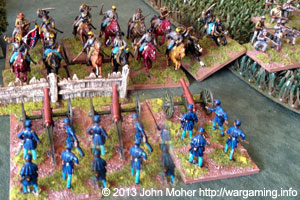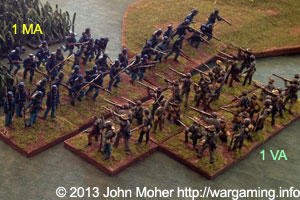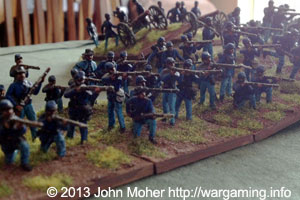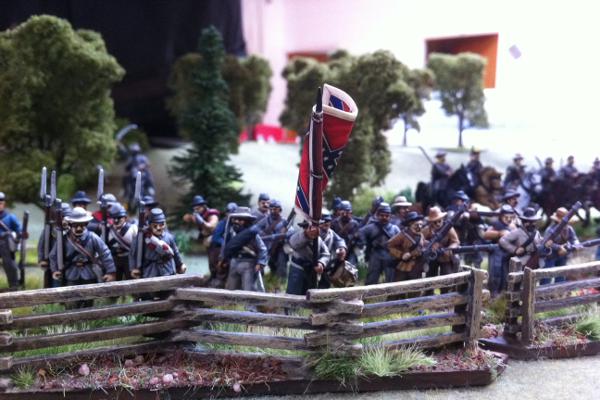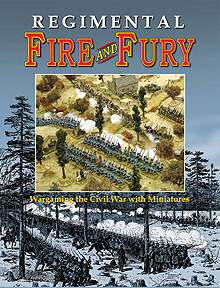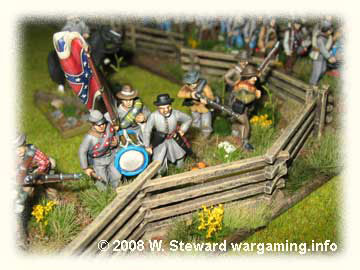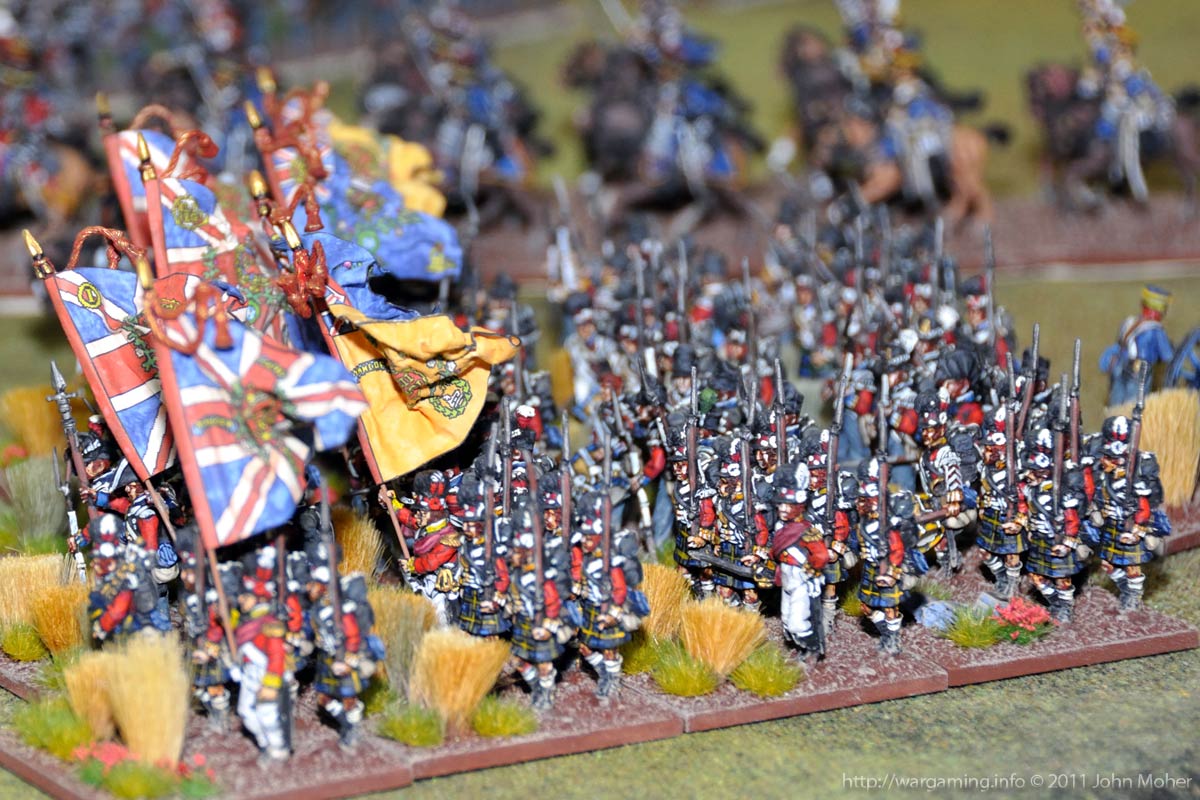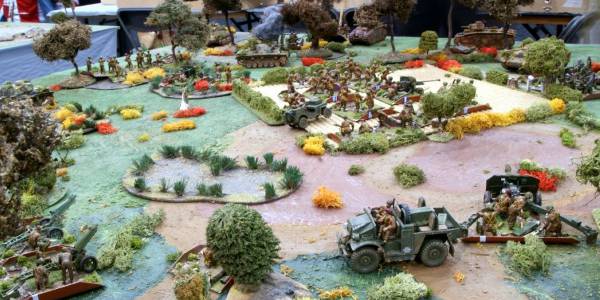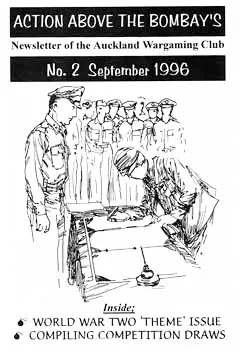As Winter thawed we did much manoeuvring around Maryland but not much became of this, and once Spring arrived we were moved to ports and embarked upon USN transports, destination initially unknown, but later revealed to be the Virginia Peninsula. By late spring we were in Virginia and marching on Richmond confident of victory under our new army commander George B. McClellan. There was minor skirmishing with the Rebels and some brisk actions, but we always stood firm and soon were continuing our irresistible movement North, my brigade was not significantly involved in these actions. we did learn from intelligence gathered that our opponents from last year, Longman’s Brigade, were part of the forces defending Richmond and we may well get a second chance to try conclusions with them… And it was at a place we dubbed Seven Pines that the Confederate’s did launch a surprise counter attack on our forces and this is where I shall take up my story…
Category: American Civil War
Marching On Richmond: Winter 1861
After our previous battle (known as ‘Warrenton Turnpike‘ to us but as the ‘March on Manassas Junction‘ to the Confederate Forces) we spent considerable time manoeuvring and counter-marching, but no further significant action was to arise in the summer of 1861. By Autumn both ourselves and the enemy were busying themselves with establishing winter quarters and stockpiling stores, and receiving reinforcements and additional ordnance. There has been much talk of the last battle, and it’s outcome – news continues to come through from Richmond and elsewhere in the south of the celebrity of my erstwhile opponent dear reader. Colonel A.P.S. Longman is currently the toast of the CSA and if we are to believe everything he may well single-handedly decide this venture, regardless of what any of us may do…!
There has been much change as we get through our fall and winter, shortly after the previously reported major engagement our “Army of Northeastern Virginia” was incorporated, as a Corps, into the new “Army of the Potomac” under one Maj. Gen. George B. McClellan – who seems a fine sort of soldier! Our new Corps remains directly under our old commander from the summer battle, Brig. Gen. Irvin McDowell. In the South we hear that the Confederate “Army of the Potomac” has undergone some changes also – and at the end of winter it is confirmed it has been renamed the “Army of Northern Virginia“.
Marching On Richmond Fast-Play Campaign
Today Cam & I kicked off a fast play ‘style’ ACW Campaign, where we start off in 1861 with an identical sized brigade each, and these will grow and change over the course of our battles, with units being reduced by attrition but gaining in experience (while also losing their élan to a degree with that experience), or being reduced to the level they are disbanded or destroyed on the battlefield, while other units will arrive to reinforce these forces, gradually increasing our commands’ from Brigades to Divisions…
It’s 1861, the United States is at war, with itself! Both North and South have called forth men to defend the sovereign claims. I have been given command of a Brigade of Volunteers in the USA Army of Northeast Virginia, currently the primary force of the Northern Army on the border of Virginia – I am Colonel Ulysses P. Rickards and I am a veteran of the ante-bellum U.S. Army, having served in the Artillery. In the vicinity of my Brigade’s encampment is a Confederate Brigade (that I am charged with observing) of the CSA Army of the Potomac, under one Colonel A.P.S. Longman, like my brigade, Colonel Longman’s is made up of fresh volunteers, and is currently covering one of the main routes into Virginia from Maryland. Colonel Longman is an extremely wealthy Virginia Land Owner, who is very well connected and pre-war was regularly featured in the fourth estate and other media – a celebrity of sorts.
Black Powder ACW at the AWC
On Sunday a couple of the guys at the AWC played their first Black Powder game set in the ACW (American Civil War) – I was unable to attend, but Lee Heath has posted a brief report and a couple of photos on his blog Project Black Powder. I’ll be looking forward to hopefully getting in on the next game and maybe I should make a start on basing up my painted 28mm Union & Rebel troops (who have been actually waiting for the balance of the figs to get painted before I base them but perhaps I should forgo that and just get on with basing them)… Continue reading “Black Powder ACW at the AWC”
Regimental Fire and Fury finally released!
At HistoriCon in late July Rich Hasenauer’s Regimental version of Fire & Fury was finally released! This is something many of us ACW Gamers have been waiting for for sometime and finally it’s here.
A Hardcover 96 page book with the same standard of colour photos & illustrations as was present in the original Brigade level rules. I’ll be looking to acquire a copy of these ASAP and see how they look – it’s also incentive to resume progress on my 28mm ACW armies! Continue reading “Regimental Fire and Fury finally released!”
Fire & Fury: The ACW in 28mm
This is an all new section – during 2009 I’ll hopefully be building brand new Armies in 28mm for use with the Fire & Fury (both Brigade & Regimental versions of the rules). Previously I played Fire & Fury extensively in 15mm, from when it was released in the early ’90s until about 2000, at which time I sold all my 15mm ACW forces & terrain. I am looking forward to getting back into it in 28mm. Continue reading “Fire & Fury: The ACW in 28mm”
Brief History Of Wargaming
The following is a brief history of modern wargaming told in quotes from various wargaming books & authors:
“It was in Europe that the early forms of wargaming gradually took on a more sophisticated appearance. During the Seventeenth Century several variations on the basic game of chess were introduced. During the Eighteenth Century a number of games were introduced into France which departed from the idea of pieces and which used series of cards designed to impart basic military knowledge to the players. Also, at about this time, silver model soldiers were being used at the French Court to instruct the future king, Louis XIV, in the art of war” – David Nash (Wargames – 1974).
Continue reading “Brief History Of Wargaming”Wargaming Periods
Periods are the “Eras” or “Level of Technology” present for wargaming. Having a Greek Army of 300 BC facing a Russian Army of 1944 AD is obviously quite a mismatch and both armies need quite different sets of rules to control how they perform. Hence we have “Periods” in which armies all operated in similar ways, or with similar weapons, and can be ‘played’ using a common set of rules.
Continue reading “Wargaming Periods”Victory Conditions in Wargames
All to often we play games with little thought about victory conditions, usually just to shoot ’em up and she’ll be right! However with a little effort and time before each game it can be given much greater depth, and consequently be more challenging and interesting to the participants. I would like to suggest some ideas for how this can be done.
Many wargamers play their games in isolation with little “purpose” behind them, the recent suggestion that a gamer’s tactics would change if their opponent got to ‘hit’ each element they lost with a heavy hammer is all too true, and it is this ‘strategic’ purpose that is lacking (we would all be very cautious if playing with the above rule)! The ideal situation to impose this ‘purpose’ is the campaign, this always puts an all new perspective to things, the opponents in a battle may not have the same objective for instance. Unfortunately 99% of the time we do not have the luxury of participating in campaigns (which is a pity) and so we need some way of creating these constraints artificially, one system I have come across is in one of my many rulebooks; “Washington’s Wars”. These rules were designed for French & Indian war action and the American Revolution, disappointingly the rule mechanics and effects on the table did not match the impressive packaging! The rules did however include one good idea about victory conditions and it is a variation of this that I will present below.
Continue reading “Victory Conditions in Wargames”